2. 上海海洋大学海洋牧场工程技术研究中心 上海 201306
2. Engineering Technology Research Center of Marine Ranching, Shanghai Ocean University, Shanghai 201306, China
海藻场是主要分布于大陆架海区硬质底上生长的大型底栖海藻与其他海洋生物群落所共同构成的一种近岸海洋生态系统,也是主要的海洋初级生产贡献者之一(章守宇等, 2007)。大型海藻通过光合作用,将大气中的CO2转化为有机碳储存在体内实现碳封存,是重要的生物碳汇,对于海洋碳汇扩增及我国双碳目标的实现具有重要意义(高亚平等, 2013; 李娇等, 2013)。海藻凋亡后在波浪潮流等冲刷作用下进入海洋,并不断分解形成有机碎屑或溶解有机物(章守宇等, 2019),其中,约80%的有机碳以海藻碎屑的形式进入海洋。海藻碎屑随海流输运沉降至近岸或离岸的无海藻覆盖海域,被底栖生物所摄食或被微生物分解利用进入生物地球化学循环过程(Steneck et al, 2002; Krumhansl et al, 2012)。海藻碎屑的输运沉降是连接不同沿海生境的重要生源要素循环形式之一,影响着海域初级生产力和次级生产力的时空分布格局。
目前,潜水摄影、碎屑标记、环境DNA采集等野外调查方法是研究海藻碎屑脱落进入海水后输运沉降过程的主要方法(Filbee-Dexter et al, 2018; Wernberg et al, 2018; Kaehler et al, 2006)。近岸海藻场有机碎屑的输运沉降受地形、潮流、波浪等动力因子时空变化的影响,野外调查对海藻碎屑时空分布的评估有明显的局限性。拉格朗日质点追踪法通过关注质点在空间中随时间变化的运动特征(陈毓敏等, 2019),可有效补充野外调查点位有限等不足,并可提供全域性评估依据。随着海洋数值模型发展成熟,数值模型中拉格朗日质点追踪法的应用也越来越广泛,目前已成功应用于海洋环流、锋面、水交换能力、溢油污染物质输运及浒苔等生物漂移路径等研究中 (丁东生等, 2016; 俞露露等, 2020; 彭兆亮等, 2020; 冯依蕾等, 2020; 高丽萍等, 2021; Saidi et al, 2014; 范世平等, 2011)。上述研究多关注质点随海流的水平输运和扩散过程,而海藻碎屑在随海流水平运动的同时,还因其自身所受重力作用而发生明显的垂向沉降。
本研究以枸杞岛西北侧天然海藻场为例,建立考虑浮筏式养殖设施阻力的水动力模型。基于拉格朗日质点追踪法,将静水试验获得的海藻碎屑沉降速度应用于模型的拉格朗日质点追踪模块,揭示天然海藻场海藻碎屑输运沉降过程的动力学机制,评估其对周边海域碳汇的贡献,以期为我国海藻场本底调查及其生态影响范围评估提供参考,并为进一步建立海藻场生态辐射模型打下基础。
1 材料与方法 1.1 研究区域模型计算区域包含长江口、杭州湾及邻近海域(图1a),重点加密枸杞岛附近海域网格以保证对枸杞岛西北侧天然岩礁海藻场(图1c)及外围大规模浮筏式贻贝养殖区的模拟精度,水动力观测站点见图1b。模型采用Arakawa C型水平网格(Arakawa et al, 1977),即流速点与水位点相差半个网格距离的交错网格,水位点位于网格中心点上,水平流速点u、v则分别位于y向、x向网格线法向上。网格数为336×256,最高分辨率约70 m。垂向采用Sigma坐标,共分为31层,重点加密枸杞岛贻贝养殖筏架及贝串所在的深度(0~3.8 m),垂向最高分辨率为水深的0.01倍。

|
图 1 模型计算域(a)、观测站点分布(b)及天然海藻场初始覆盖率(c) Fig.1 Model calculation domain (a), observation sites (b), and initial coverage of natural seaweed (c) 图a白色虚线:重点加密区域;图b黑色虚线:贻贝养殖区范围;图c:彩色虚线表示特征区块。 (a) white dotted line indicates focused encrypted areas; (b) Black dotted lines indicate borderlines of mussel farms; (c) Colored dotted lines indicate feature zones. |
模型由开边界的潮位驱动,共考虑16个主要分潮,潮边界的振幅和迟角数据由TPXO 7.1数据集插值得到,该数据集在沿海的分辨率最高可达1/30°(Egbert et al, 2002; 温英等, 2022)。
1.2 拉格朗日质点追踪模型 1.2.1 水动力模型简介本研究所使用的ECOM-si三维海洋数值模式(estuarine coastal ocean model, semi-implicit)由POM(Princeton ocean model)改进而来,并发展为非正交坐标系模型(朱建荣等, 2003; Wu et al, 2010)。
枸杞岛西北侧海藻场外围存在大规模的贻贝浮筏式养殖设施,其对水动力的改变不可忽视。本研究采用动量汇法实现对浮筏式养殖设施阻流效应的模拟,即考虑浮筏式养殖阻流作用导致海水流速的部分动量损失,在模型的动量方程组中添加计算这部分动量损失(Yang et al, 2013; Li et al, 2017),实现对浮筏式养殖阻流效应的数值模拟(温英等, 2022)。
1.2.2 拉格朗日质点追踪模块拉格朗日质点追踪模块中质点的运动包括3个过程:质点随模型流场的平流过程;质点受湍流作用造成的随机运动;质点因自身重量产生的垂向下沉运动。具体公式如下(Ali et al, 2013; Ju et al, 2009):
| $ \begin{gathered} L{\left( {x,y,z} \right)_{{t_0} + \Delta t}} = L{\left( {x,y,z} \right)_{{t_0}}} + \left( {\begin{array}{*{20}{c}} {{u_{{t_0}}} + \frac{{\partial {A_H}}}{{\partial x}}} \\ {{v_{{t_0}}} + \frac{{\partial {A_H}}}{{\partial y}}} \\ {{w_{{t_0}}} + \frac{{\partial {K_H}}}{{\partial z}} - {w_L}} \end{array}} \right)\Delta t + \hfill \\ \;\;\;\;\;\;\left( {\begin{array}{*{20}{c}} {\sqrt {2{A_H}} }&0&0 \\ 0&{\sqrt {2{A_H}} }&0 \\ 0&0&{\sqrt {2{K_H}} } \end{array}} \right){\gamma _n}\Delta t \hfill \\ \end{gathered} $ | (1) |
式中,
海藻碎屑静水沉降速度数据来自课题组前期研究,以枸杞岛优势藻种孔石莼(Ulva lactuca L.)和舌状蜈蚣藻[Grateloupia livida (Harv). Yamada](章守宇等, 2018)碎屑为研究对象,通过海藻碎屑室内静水沉降试验获得不同粒径大小海藻碎屑的沉降速度范围为0.5~2.3 cm/s。本研究数值模拟试验取0.5、1.4、2.3 cm/s作为不同大小粒径海藻碎屑的沉降速度。各个试验设置质点运动至模型0.98倍水深时表示海藻碎屑沉底。
海藻场是具有周期性生长和凋落的生态系统,6、7月海藻生长旺盛,8月海藻生物量达到峰值后开始凋落,释放大量有机碎屑进入海洋(陈亮然等, 2015; 韩军军等, 2016)。数值模拟试验所用海藻场初始覆盖率数据源自2018年枸杞岛西北侧夏季天然海藻场调查结果,藻场有效面积S0约为22.33 hm2,平均覆盖率F约为23.6% (贾慧明, 2020);全球海藻生态系统平均固碳量W为22.38 kg C/(hm2·d),约79.5%在海藻凋落期以有机碎屑的形式进入海洋(Mateo et al, 2006),见表1。模型试验设置枸杞岛西北侧天然海藻场向周边海域输送的碳汇源强CIni,计算公式如下:
|
|
表 1 海藻生态系统固碳量及有机碎屑侵蚀量 Tab.1 Carbon sequestration and organic detritus erosion in seaweed ecosystems |
| $ {C_{Ini}} = (79.5\% \times W) \times {S_0} \times F $ | (2) |
式中,(79.5%×W)为海藻场凋落期有机碎屑脱落量,计算得到海藻场向海洋输送的CIni为93.76 kg C/d。
数值试验依据图1c所示海藻场覆盖率,在不同空间位置按比例释放不同数量的质点,以体现海藻场向海洋输送有机碎屑源强的空间分布差异。每个位置间隔1 h连续释放75批海藻碎屑质点(约6个M2分潮历时)以保证海藻场向海洋输送碎屑的连续性,每批合计从不同位置释放共1264个海藻碎屑质点。根据碳汇源强CIni换算单个海藻碎屑质点含碳量C0约为3.1 g。碳汇值Cs根据海藻碎屑质点在研究区域内访问不同区域的频率次数,即拉格朗日指标Ps (陈毓敏等, 2019)计算。通过将研究区域划分为面积相等的网格,并统计每个网格内质点的数量可得Ps,计算公式如下:
| $ {P_s}\left( {x,y} \right) = \frac{{\mathop \sum \nolimits^ N(x,y)}}{S} $ | (3) |
| $ {C_s}(x,y) = {P_s}(x,y) \times {C_0} $ | (4) |
式中,
图2为拉格朗日漂流浮标(简称漂流瓶)的简易模型。漂流瓶高度为30 cm,含防水罩高约10 cm,入水部分约20 cm。以稳定板为分界,GPS密封于防水罩中,露出水面接收反馈位置信息。下半部分用密度较大的沉子使漂流瓶大部分没入水中,同时降低重心保证稳定性。漂流瓶通过室内静水试验,调整沉子的质量,保证漂流瓶入水后稳定板恰好与水面贴合,随海流运动时保持姿态稳定,达到兼顾信号反馈以及减少海表面风应力作用的效果。拉格朗日漂流浮标每隔10 s接收位置信息并反馈给终端,取10 min平均位置信息,统计其在不同时刻的位置。于2021年5月21日在枸杞岛西北侧海域依次投放6个漂流瓶(图3)。

|
图 2 拉格朗日漂流浮标 Fig.2 Lagrangian drifting buoy |
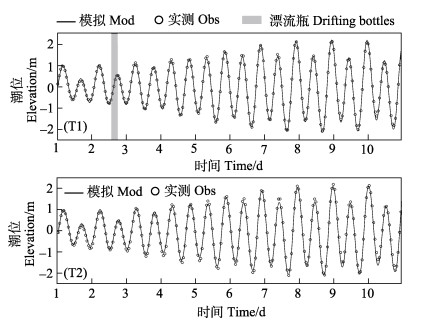
|
图 3 潮位时间序列验证 Fig.3 Time series of elevation T1:嵊山站;T2:绿华山站 T1: Shengshan; T2: Lühua |
利用嵊山站(T1)和绿华山站(T2) 2个验潮站的观测数据验证模型输出的潮位时间序列,结果显示模型精度较高(图3)。表2所示相关性系数(r)、均方根误差(rms)和Skill值(Skill)三种评价方法(Lin et al, 2016; 林军等, 2020)反映的模型结果与实测值的吻合程度也为优良。
|
|
表 2 潮位模拟误差值 Tab.2 Error of tidal elevation modeling |
在贻贝浮筏式养殖场内的S1站点和场外的S2站点,使用声学多普勒流速剖面仪(ADCP)获取表层、中层和底层流速、流向实测资料用于模型值对比验证(图4、图5)。S1和S2站点的流速差异主要表现为场内S1站点表层流速受贻贝养殖活动的阻碍而减小。S1站点实测和模拟流速整体不超过0.8 m/s,表层流速不超过0.2 m/s,均呈现了表层流速小、中层和底层流速大的垂向结构。流向的模拟精度在中层和底层模拟较高,因表层流速较小,导致表层流向模拟精度一般。位于养殖场外的S2站点的流速流向模拟精度相对较高。综上所述,本研究所建数值模型达到一定精度,可为应用拉格朗日质点追踪法研究海藻碎屑输运沉降过程提供可靠的水动力基础。
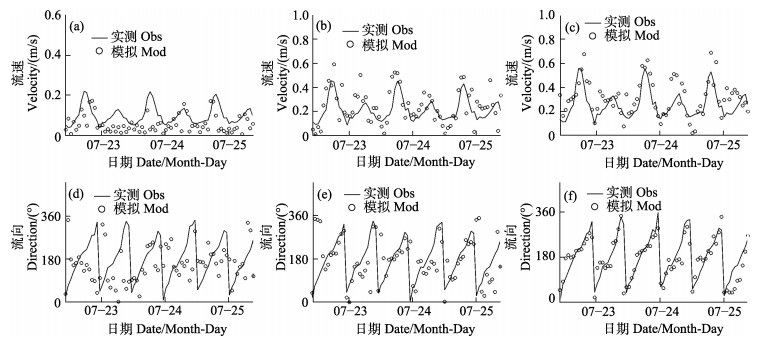
|
图 4 S1站点流速和流向序列验证 Fig.4 Comparisons of velocity and direction of observation and model in S1 site a、b、c分别表示表、中、底层流速;d、e、f分别表示表、中、底层流向 a, b, and c represent the flow velocity of the surface, middle and bottom layer, respectively; d, e, and f represent the flow direction of the surface, middle and bottom layer, respectively |
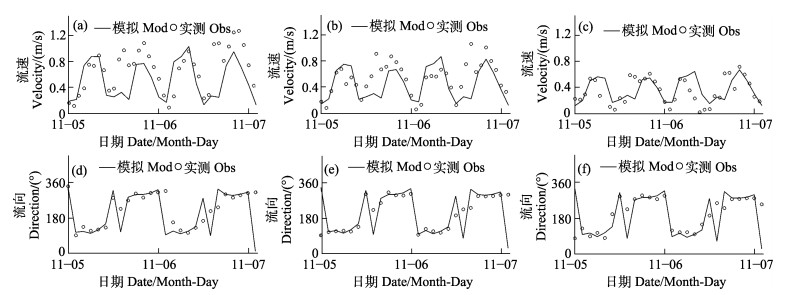
|
图 5 S2站点流速和流向序列验证 Fig.5 Comparisons of velocity and direction of observation and model in S2 site a、b、c分别表示表、中、底层流速;d、e、f分别表示表、中、底层流向 a, b, and c represent the flow velocity of the surface, middle and bottom layer, respectively; d, e, and f represent the flow direction of the surface, middle and bottom layer, respectively |
设置模型中质点释放时间与漂流瓶释放时间一致,利用实测漂流浮标轨迹对数模中拉格朗日质点代表的有机碎屑颗粒运动轨迹进行验证。模型质点释放位置以漂流瓶释放位置为中心,等间距(间隔100 m)选择9个位置释放质点,每个位置释放5个拉格朗日质点,共计释放45个质点。
研究区域的潮汐是以半日分潮为主的混合潮,远离岛屿的海域为顺时针旋转流,岛间海域则为往复流,潮流涨急和落急时刻流向为西北和东南向(温英等, 2022)。图6为模型质点和漂流浮标运动轨迹,质点模拟与漂流瓶的运动时长相同。在涨潮流的作用下,漂流瓶a、b、c及其模拟质点轨迹显示向西北运动,而后随潮流发生转向,漂流瓶及质点运动方向转向东及东南,轨迹呈顺时针旋转特征。漂流瓶d、e与其模拟质点的运动轨迹呈现接近往复流的特征,其运动区域在枸杞岛与其北部的壁下岛之间,潮波运动受岛屿地形的制约较强,故呈往复流特征。漂流瓶f与其模拟质点在落潮流作用下沿嵊山岛东侧运动,继而随涨潮流从嵊山岛和枸杞岛南侧转向西运动。漂流瓶a在漂移约6 h时,运动方向由正北异常转向西南,因其位于主航道,受人为或船只等因素影响,模型质点对其后期运动轨迹模拟的偏差较大。模型对其他漂流瓶全时段的运动轨迹的模拟基本一致,反映了枸杞岛及邻近海域潮流系统的基本特征。在不考虑风应力驱动的前提下,数值模型拉格朗日质点追踪模块的模拟精度良好,可用于海藻碎屑输运沉降过程的模拟。
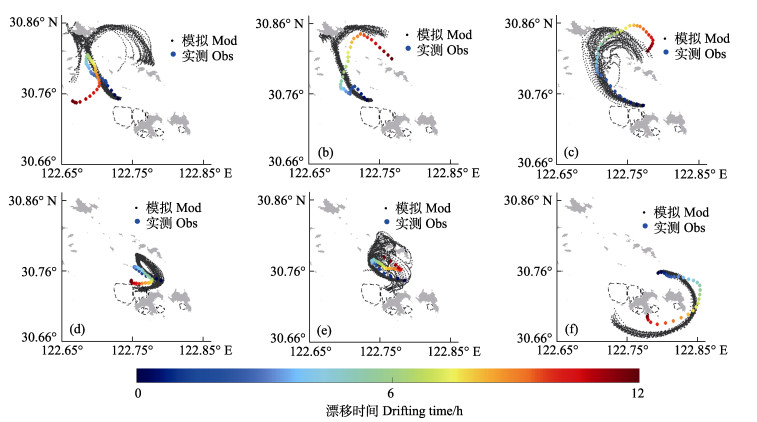
|
图 6 漂流瓶与质点漂移轨迹对比 Fig.6 Verification results of measured trajectories of Lagrangian drifting bottles and simulated trajectories of Lagrange particles 彩色实心点:漂流瓶轨迹;颜色:漂移时间;黑色实心点:模型拉格朗日质点轨迹。 Colored solid points indicate drift bottle trajectories. Different colors indicate different drifting time. Black solid points indicate modeled Lagrange particle trajectories. |
数值模型水动力模块的潮位、流速对定点实测资料的模拟精度良好,再现了枸杞岛天然海藻场及其邻近海域的水动力特征(温英等, 2022),拉格朗日质点追踪模块也通过了漂流浮标轨迹资料的验证。通过设置不同粒径海藻碎屑的沉降速率不同,解决了大范围海域中难以测量碎屑输运沉降规律和碳汇分布等问题。此外,数值模型中拉格朗日质点设置为密度与水体相同,而漂流浮标密度与水体有较大差异,自由度高(陈毓敏等, 2019),随水体的运动存在滞后或惯性作用。且漂流浮标有部分露出水面接收位置信号,会受海表面风的作用。而海藻碎屑密度小,与水体间的黏性比漂流浮标大,随水体的运动时有更加近似水质点的性质。综上所述,可以认为数值模型中设定的拉格朗日质点对海藻碎屑的模拟较漂流浮标更切合实际情况,拉格朗日质点追踪法应用于海藻碎屑输运沉降过程研究具有较高的可行性。
2.4 海藻碎屑输运沉降空间分布规律潮流作为影响海洋物质输运的重要动力学因子,深刻影响海藻碎屑沉降分布的空间格局。海藻碎屑因自重导致其在水平输运过程中发生显著的垂向沉降,也是影响海藻碎屑沉降分布空间格局的重要因素之一。本研究设置了不同质点释放时刻(大潮、小潮)、不同沉降速度(0.5、1.4和2.3 cm/s)条件下的6组数值试验,每个试验释放94 800个海藻碎屑质点。结果显示,海藻碎屑质点自进入海洋后,绝大多数在24 h内沉降至海底停止运动。图7统计了每公顷海藻碎屑质点累积沉降数量,结果显示,天然海藻场邻近海域是海藻碎屑沉降的高值区,分布特征沿海藻场离岸递减。海藻场西北侧是大面积的贻贝浮筏式养殖场,极大地削弱了水动力强度,加之近岸水深浅和海藻碎屑自身沉降过程的作用,海藻碎屑在进入开阔海域前便沉降至近岸海底。进入开阔海域后的海藻碎屑受涨落潮流的作用,沉降数量呈现以海藻场中心5 km左右范围内为高值区,并向西北–东南向递减的空间分布态势,与该海域涨落急方向及漂流浮标运动特征一致。近岸海域每公顷累计海藻碎屑质点沉底数量最高值范围在549~813 ind./hm2之间,因水动力和沉降速度差异导致海藻碎屑质点沉降数量的空间分布差异显著(图7和表2)。
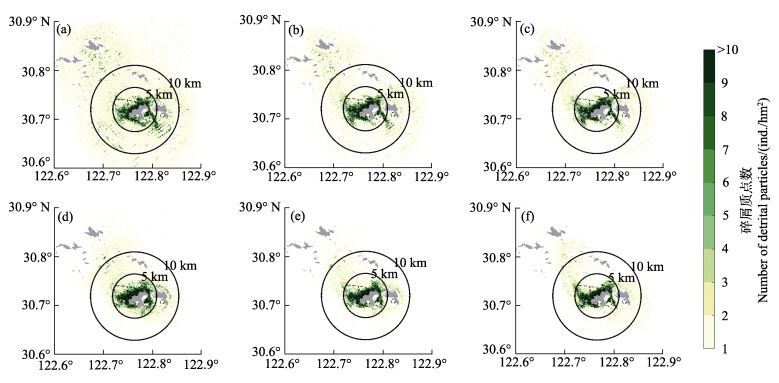
|
图 7 单位面积(hm2)海藻碎屑质点沉降数量 Fig.7 Number of seaweed detritus particles settled per hectare a、b、c:大潮期间,沉降速度为0.5、1.4和2.3 cm/s的海藻碎屑沉底数量分布;d、e、f:小潮期间,沉降速度为0.5、1.4和2.3 cm/s的海藻碎屑沉底数量分布;图中黑色圆圈分布表示距海藻场中心5 km、10 km的范围(下同) a, b, and c represent settling velocities of 0.5, 1.4, and 2.3 cm/s during spring tide, respectively. d, e, and f represent settling velocities of 0.5, 1.4, and 2.3 cm/s during neap tide, respectively. The black circles indicate the range of 5 km and 10 km from the center of the seaweed field (the same below), respectively. |
表3统计了海藻碎屑沉底时距释放位置距离的不同占比。小潮期间,海水运动对海藻碎屑的输运能力弱,海藻碎屑主要沉降至海藻场邻近海域,输运距离多小于5 km。如图7d、e、f所示,海藻碎屑沉降高值区主要集中在距海藻场中心5 km内,有超过70%以上的海藻碎屑输运距离小于2 km (表3),而5 km以外海域单位面积海藻碎屑质点数基本不超过10 ind./hm2。大潮期间,海水输运能力强,沉降至外海域的海藻碎屑数量明显增加。沉降速度(w=0.5 cm/s)较小时,海藻场向周边海域输送碎屑沉降分布范围明显变大(图7a),5 km以外海藻碎屑质点数量占总量的29%,10 km以外占14%。外围海域部分水深较浅区域,单位面积海藻碎屑质点数量超过10 ind./hm2。沉降速度(w为1.4和2.3 cm/s)较大时,海藻碎屑沉降分布范围缩小,但仍有相当一部分被输送至5 km和10 km以外海域(图7b、c),为外围海域碳汇提供一定贡献。
|
|
表 3 不同沉降速度下海藻碎屑的输运距离占比 Tab.3 Percentage of transport distance of seaweed detritus at different sedimentation rate |
海藻碎屑脱落进入海洋的时刻同样是影响其输运的因素之一。大潮期间,有较多的海藻碎屑被输运沉降至较远的外围海域(图7和表3)。因此,对大潮期间涨潮和落潮时所脱落海藻碎屑的输运距离进行平均,以讨论涨潮和落潮两个典型时刻对碎屑输运的影响。因落潮流受岛屿地形遮蔽作用,导致碎屑的平均输运距离随着涨落潮呈波动变化,输运峰值距离(5.5 km)出现在涨潮期间(图8)。涨潮流将碎屑向西北较开阔海域输送,碎屑粒径越小(沉降速率越小),其沉入海底之前受潮流作用越久,输运距离更远,沉降范围更广。
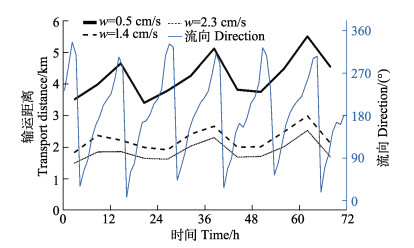
|
图 8 涨落潮期间海藻碎屑输运距离平均值对比 Fig.8 Comparison of average transport distance of seaweed detritus during flood tide and ebb tide 黑色实线由粗到细表示0.5、1.4、2.3 cm/s的沉降速度;蓝色实线表示流向。 Solid black lines from thick to thin indicate settling velocities of 0.5, 1.4, and 2.3 cm/s, respectively. Solid blue lines indicate flow direction. |
海藻碎屑的离岸输运除受粒径大小(沉降速率不同)、水动力强弱及脱落时的涨落潮方向影响外,海藻场的区位也非常重要。粒径越小的海藻碎屑沉降速率越小、输运距离越远,沉降位置分布受海藻场区位的影响越显著。以沉降速度为0.5 cm/s的海藻碎屑为例,分析了海藻场3个特征区块内(图1c)所脱落碎屑的沉降位置分布(图9)。
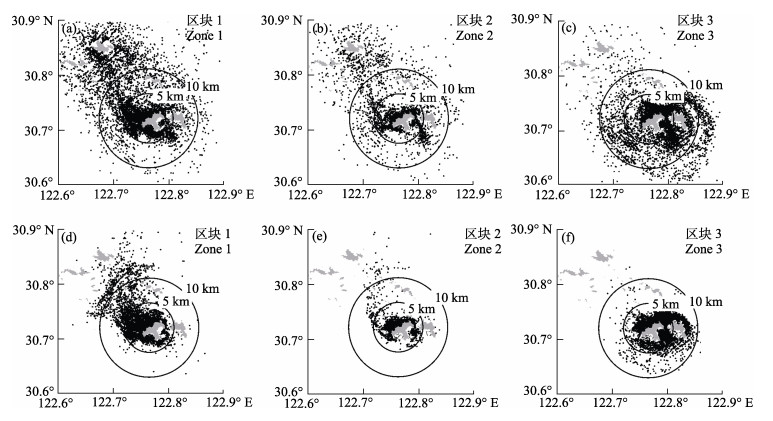
|
图 9 海藻场不同特征区块海藻碎屑沉降分布(w=0.5 cm/s) Fig.9 Distribution of seaweed detritus sinking to the bottom in the characteristic block of seaweed during spring and neap tides(w=0.5 cm/s) a、b、c:大潮时,特征区块1、2、3内海藻碎屑沉底分布;d、e、f:小潮时,特征区块1、2、3内海藻碎屑沉底分布 a, b, and c are the distribution of seaweed detritus sinking in feature zone 1, 2 and 3 during spring tide, respectively. d, e, and f are distribution of seaweed detritus sinking in feature zone 1, 2 and 3 during neap tide, respectively. |
特征区块1位于枸杞岛西侧,潮流在受地形遮蔽作用相对较小的开阔位置。海藻碎屑沉降分布集中于海藻场西北侧,受涨潮流作用显著。小潮时,沉降分布集中于5 km以内海域。大潮时,沉降分布范围广,约25%的海藻碎屑沉降至10 km以外海域(图9a、d)。区块2位于枸杞岛西北侧中段,地形相对封闭,且外侧被大量养殖设施包围,水动力较弱。海藻碎屑主要沉降于沿岸海域,大潮时,仅有约8%海藻碎屑输运距离超过10 km (图9b)。区块3位于枸杞岛北侧沿岸,向西北的涨潮流被地形遮蔽,受落潮流作用明显,其沉降区分布更多集中于枸杞岛和嵊山岛之间及其南侧海域,以及嵊山岛东侧海域。综上所述,海藻场处于地形相对开阔、水流通畅的位置时,其生态辐射范围更大。
3.2 天然海藻场对周边海域碳汇的贡献如前文所述,枸杞岛西北侧天然海藻场在凋落盛期向周边海域输送的碳汇源强为93.6 kg C/d。根据数值模拟试验海藻碎屑沉底数量统计结果(图7)并结合碎屑含碳量,可计算海藻场对周围海域单位面积日均碳汇值Cs,反映海藻场对周边海域的碳汇贡献和生态辐射功能(图10)。
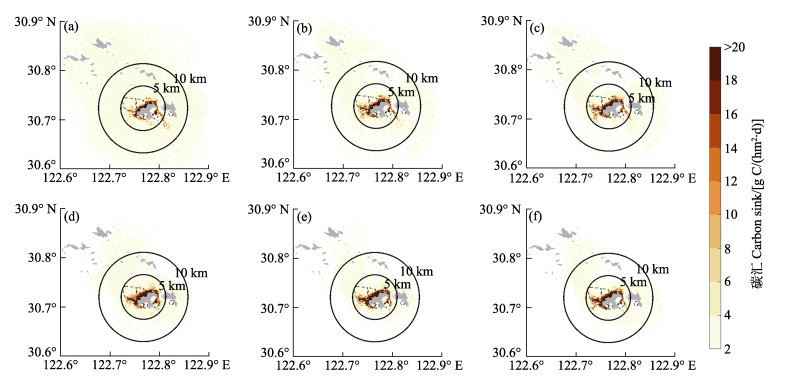
|
图 10 海藻场对周边海域碳汇贡献 Fig.10 Contribution of seaweed to carbon sink of surrounding sea area a、b、c:大潮,沉降速度分别为0.5、1.4、2.3 cm/s;d、e、f:小潮,沉降速度分别为0.5、1.4、2.3 cm/s a, b, and c: Settling velocities of 0.5, 1.4, and 2.3 cm/s during spring tide, respectively; d, e, and f: Settling velocities of 0.5, 1.4, and 2.3 cm/s during neap tide, respectively. |
水动力和海藻碎屑重力是影响海藻场对周边海域碳汇贡献和生态辐射功能的重要因素(Krause- Jensen et al, 2016)。大潮期间,海藻场碳汇贡献不局限于近岸(图10a、b、c)。海藻场为5 km外海域贡献约7.5~33.7 kg C/d碳汇。碎屑粒径越小,输运距离越远(Kelly et al, 2012; Wernberg et al, 2008),对外围海域碳汇贡献的范围越大。粒径较小的海藻碎屑(w=0.5 cm/s),约14% (总碳含量约13 kg C)沉降至10 km以外海域。海藻场对外围海域的日均碳汇贡献不超过10 g C/(hm2·d),但辐射范围较广,最远可达20 km左右。小潮期间水动力较弱,海藻场对周边海域的碳汇贡献范围较小,但单位面积的强度大。碳汇贡献集中分布于沿岸海藻场邻近海域,且离岸递减(Krumhansl et al, 2011)。5 km以内海域日均碳汇总量约84 kg C (图10d、e、f)。碎屑粒径越大,为近岸海域提供碳汇贡献越大,最高约为817 g C/(hm2·d),而大潮时最高为699 g C/(hm2·d)。受岛礁及贻贝养殖设施对潮流的遮蔽和削弱作用,海藻场的碳汇分布呈以海藻场邻近海域为中心的高值区,向西北–东南方向(涨落急潮流方向)递减的空间分布格局。涨潮流对外海域碳汇贡献比落潮流显著。此外,不同位置海藻场的碳汇贡献和生态辐射功能对涨落潮的响应不同(图9)。
本研究设置枸杞岛西北侧天然海藻场的平均固碳量为22.4 kg C/(hm2·d),约为海洋中浮游植物初级生产力3.6 kg C/(hm2·d)的6倍(Mateo et al, 2006; Krumhansl et al, 2012),极大地提高了海域的初级生产力。但是,近年来我国海藻场在全球气候变化、海洋酸化和人类活动等因素的干扰下,有效面积越来越小(章守宇等, 2019),初级生产力也在减弱。除在生长期促进海域初级生产力外,海藻场在凋落期会释放大量有机碎屑,海藻场的生态辐射功能对促进邻近海域碳汇和次级生产力也具有重要意义。大潮期间,海藻场的生态辐射范围更广;小潮期间,输运距离较远的小粒径碎屑同样对外围海域有较强的碳汇贡献。海藻碎屑凋落后,粒径较大的碎屑在输运过程中继续破碎分解为粒径更小的碎屑(Watanabs et al, 2009),对外围海域碳汇贡献有很大的潜力。海藻场的生态辐射功能不仅受水动力影响,还与碎屑粒径大小、凋落时的涨落潮时刻及海藻场所处区位等有密切联系。海藻场向海洋输送有机碎屑的能力不仅与自身生物量有关,还与所处海域潮振幅、波浪强度、风应力等有密切关系(Krumhansl et al, 2011)。后续研究应将海藻场对物理动力环境的响应、海藻碎屑生物量在输运过程中随时间的变化等加入到模型的计算中。此外,本研究不同粒径海藻碎屑为含碳量相同的单一质点,在后续研究中应增加不同海藻碎屑含碳量差异,提高碳汇计算精度。
ALI A, THIEM O, BERNTSEN J. Numerical simulation of flow and aquaculture organic waste dispersion in a curved channel. Ocean Dynamics, 2013, 63(9/10): 1073-1082 |
ARAKAWA A, LAMB V R. Computational design of the basic dynamical processes of the UCLA general circulation model. General Circulation Models of the Atmosphere, 1977, 17: 173-265 |
CHEN L R, ZHANG S Y, CHEN Y, et al. Life history and morphology of Sargassum horneri from the Sargassum seaweed bed of Gouqi Island. Journal of Fisheries of China, 2015, 39(8): 1218-1229 [陈亮然, 章守宇, 陈彦, 等. 枸杞岛马尾藻场铜藻的生命史与形态特征. 水产学报, 2015, 39(8): 1218-1229] |
CHEN Y M, XIANG J, DU H D, et al. Numerical simulation of Kuroshio path based on Lagrangian method. Marine Forecasts, 2019, 36(6): 22-28 [陈毓敏, 项杰, 杜华栋, 等. 基于拉格朗日方法对黑潮路径的数值模拟. 海洋预报, 2019, 36(6): 22-28] |
DING D S, MA S S, CHEN B J, et al. Evaluation of the natural fishery resources loss caused by an oil spill accident in the central Bohai Sea based on Euler-Lagrange method. Progress in Fishery Sciences, 2016, 37(4): 36-42 [丁东生, 马绍赛, 陈碧鹃, 等. 基于欧拉–拉格朗日方法的某溢油事故天然渔业资源损失评估方法案例研究. 渔业科学进展, 2016, 37(4): 36-42] |
EGBERT G D, EROFEEVA S Y. Efficient inverse modeling of barotropic ocean tides. Journal of Atmospheric and Oceanic Technology, 2002, 19(2): 183-204 DOI:10.1175/1520-0426(2002)019<0183:EIMOBO>2.0.CO;2 |
FAN S P, WANG Y F, FENG M Q, et al. Particle tracking random simulation on advection diffusion of pollutants. Engineering Journal of Wuhan University, 2011, 44(1): 32-36 [范世平, 王彦芳, 冯民权, 等. 污染物迁移扩散的质点追踪随机模拟. 武汉大学学报(工学版), 2011, 44(1): 32-36] |
FENG Y L, ZHANG X Q, YU J Z, et al. Study on material transport characteristics in Jiaozhou Bay based on Lagrangian method. Marine Environment Science, 2020, 39(1): 106-113 [冯依蕾, 张学庆, 于金珍. 基于拉格朗日方法的胶州湾物质输运特征研究. 海洋环境科学, 2020, 39(1): 106-113] |
FILBEE-DEXTER K, WERNBERG T, NORDERHAUG K M, et al. Movement of pulsed resource subsidies from kelp forests to deep fjords. Oecologia, 2018, 187: 291-304 DOI:10.1007/s00442-018-4121-7 |
GAO L P, FAN D J, SONG D H, et al. Numerical simulation of the migration path during the growth period of Ulva prolifera in the sea near northern Jiangsu and the thermohaline environment. Haiyang Xubao, 2021, 43(8): 1-16 [高丽萍, 范德江, 宋德海, 等. 苏北浒苔生长期运移路径及温盐环境的数值模拟. 海洋学报, 2021, 43(8): 1-16] |
GAO Y P, FANG J G, TANG W, et al. Seagrass meadow carbon sink and amplification of the carbon sink for eelgrass bed in Sanggou Bay. Progress in Fishery Sciences, 2013, 34(1): 17-21 [高亚平, 方建光, 唐望, 等. 桑沟湾大叶藻海草床生态系统碳汇扩增力的估算. 渔业科学进展, 2013, 34(1): 17-21 DOI:10.3969/j.issn.1000-7075.2013.01.003] |
HAN J J, BAI K Q, ZHAO M L, et al. Morphological observation of Sargassum vachellianum sexual reproduction and juvenile sporophyte development. Acta Hydrobiologica Sinica, 2016, 40(6): 1215-1220 [韩军军, 白凯强, 赵明林, 等. 瓦氏马尾藻有性繁殖和幼孢子体发育的形态学观察. 水生生物学报, 2016, 40(6): 1215-1220] |
HAYASHIDA F. On age and growth of a brown alga, Ecklonia cava. KJELLMAN, forming aquatic forest. Nippon Suisan Gakkaishi, 1977, 43(9): 1043-1051 DOI:10.2331/suisan.43.1043 |
JIA H M. Assessment on seaweed beds resources based on BioSonics MX echosounder. Master´s Thesis of Shanghai Ocean University, 2020 [贾慧明. 基于BioSonics MX回声探测仪的海藻场藻类资源评估研究. 上海海洋大学硕士研究生学位论文, 2020]
|
JU L, JIANG W S, FENG S Z. A Lagrangian mean theory on coastal sea circulation with inter-tidal transports. Numerical experiments. Acta Oceanologica Sinica, 2009, 28(1): 1-14 |
KAEHLER S, PAKHOMOV E A, KALIN R M, et al. Trophic importance of kelp-derived suspended particulate matter in a through-flow sub-Antarctic system. Marine Ecology Progress, 2006, 316: 17-22 DOI:10.3354/meps316017 |
KELLY J R, KRUMHANSL K A, SCHEIBLING R E. Drift algal subsidies to sea urchins in low-productivity habitats. Marine Ecology Progress, 2012, 452: 145-157 DOI:10.3354/meps09628 |
KRAUSE-JENSEN D, DUARTE C M. Substantial role of macroalgae in marine carbon sequestration. Nature Geoscience, 2016, 9(10): 737-742 DOI:10.1038/ngeo2790 |
KRUMHANSL K A, SCHEIBING R E. Detrital production in Nova Scotian kelp beds: Patterns and processes. Marine Ecology Progress, 2011, 421: 67-82 DOI:10.3354/meps08905 |
KRUMHANSL K A, SCHEIBLING R E. Production and fate of kelp detritus. Marine Ecology Progress Series, 2012, 467(10): 281-302 |
LI J, GUAN C T, GONG P H, et al. Preliminary analysis of carbon sink mechanism and potential of artificial reef ecosytem. Progress in Fishery Sciences, 2013, 34(1): 65-69 [李娇, 关长涛, 公丕海, 等. 人工鱼礁生态系统碳汇机理及潜能分析. 渔业科学进展, 2013, 34(1): 65-69 DOI:10.3969/j.issn.1000-7075.2013.01.010] |
LI X, LI M, MCLELLAND S J, et al. Modelling tidal stream turbines in a three-dimensional wave-current fully coupled oceanographic model. Renewable Energy, 2017, 114: 297-307 DOI:10.1016/j.renene.2017.02.033 |
LIN J, LI C, BOSWELL K M, et al. Examination of winter circulation in a northern Gulf of Mexico estuary. Estuaries and Coasts, 2016, 39(4): 879-899 DOI:10.1007/s12237-015-0048-y |
LIN J, WU X C, YANG W. Numerical modelling of sediment transport in artificial seamount under tidal current. Journal of Fisheries of China, 2020, 44(12): 2087-2099 [林军, 吴星辰, 杨伟. 潮流作用下人工鱼礁山海域泥沙输运的数值模拟研究. 水产学报, 2020, 44(12): 2087-2099] |
MATEO M, CEBRIAN, DUNTON K, et al. Carbon flux in seagrass ecosystems. AIP Publishing, 2006, 159-192 |
PENG Z L, CHEN C R, WAN J, et al. Water particle tracking in inflow water for Hongze Lake and Lake Chaohu based on Lagrangian method. Oceanologia et Limnologia Sinica, 2020, 51(6): 1275-1287 [彭兆亮, 陈昌仁, 万骏, 等. 基于拉格朗日方法的洪泽湖与巢湖河流出入湖水体追踪计算. 海洋与湖沼, 2020, 51(6): 1275-1287] |
SAIDI M S, RISMANIAN M, MNOJEZI M, et al. Comparison between Lagrangian and Eulerian approaches in predicting motion of micron-sized particles in laminar flows. Atmospheric Environment, 2014, 89: 199-206 DOI:10.1016/j.atmosenv.2014.01.069 |
STENECK R M, GRAHAM M H, BOURQUE B J, et al. Kelp forest ecosystems: Biodiversity, stability, resilience and future. Environment, 2002, 29(4): 436-459 |
WATANABE S, METAXAS A, SCHEIBING R E. Dispersal potential of the invasive green alga Codium fragile ssp. fragile. Journal of Experimental Marine Biology and Ecology, 2009, 381(2): 114-125 DOI:10.1016/j.jembe.2009.09.012 |
WEN Y, LIN J, YANG G L, et al. Study on hydrodynamic effect of suspended mussell aquaculture facilities and detrius transportation of epiphytic seaweed. Journal of Shanghai Ocean University, 2022, 31(3): 70-82 [温英, 林军, 杨冠林, 等. 贻贝浮筏养殖设施水动力效应及附生海藻碎屑输运的数值模拟. 上海海洋大学学报, 2022, 31(3): 70-82] |
WERNBERG T, FILBEE-DEXTER K. Grazers extend blue carbon transfer by slowing sinking speeds of kelp detritus. Scientific Reports, 2018, 8: 17180 DOI:10.1038/s41598-018-34721-z |
WERNBERG V T. Detached kelps from distant sources are a food subsidy for sea urchins. Oecologia, 2008, 157(2): 327-335 DOI:10.1007/s00442-008-1061-7 |
WU H, ZHU J R. Advection scheme with 3rd high-order spatial interpolation at the middle temporal level and its application to saltwater intrusion in the Changjiang estuary. Ocean Modelling, 2010, 33: 33-51 DOI:10.1016/j.ocemod.2009.12.001 |
YANG Z, WANG T, COPPING A E. Modeling tidal stream energy extraction and its effects on transport processes in a tidal channel and bay system using a three-dimensional coastal ocean model. Renewable Energy, 2013, 50: 605-613 DOI:10.1016/j.renene.2012.07.024 |
YU L L, KUANG C P, GU J, et al. The comparative analysis of water exchange characteristics under artificial island by Eulerian and Lagrangian method. Chinese Journal of Hydrodynamics(A), 2020, 35(4): 488-496 [俞露露, 匡翠萍, 顾杰, 等. 欧拉法和拉格朗日法比较分析人工岛工程下水体交换特性. 水动力学研究与进展(A), 2020, 35(4): 488-496] |
ZHANG S Y, LIU S R, ZHOU X J, et al. Ecological function of seaweed-formed habitat and discussion of its application to sea ranching. Journal of fisheries of China, 2019, 43(9): 2004-2014 [章守宇, 刘书荣, 周曦杰, 等. 大型海藻生境的生态功能及其在海洋牧场应用中的探讨. 水产学报, 2019, 43(9): 2004-2014] |
ZHANG S Y, SUN H C. Research progress of seaweed field ecosystem and its engineering. Chinese Journal of Applied Ecology, 2007, 18(7): 1647-1653 [章守宇, 孙宏超. 海藻场生态系统及其工程学研究进展. 应用生态学报, 2007, 18(7): 1647-1653 DOI:10.3321/j.issn:1001-9332.2007.07.038] |
ZHANG S Y, XIANG C, ZHOU X J, et al. Photosynthetic fluorescence characteristics of six macroalgae species in seaweed beds of Gouqi Island. Chinese Journal of Applied Ecology, 2018, 29(10): 3441-3448 [章守宇, 向晨, 周曦杰, 等. 枸杞岛海藻场6种大型海藻光合荧光特性比较. 应用生态学报, 2018, 29(10): 3441-3448] |
ZHU J R. Ocean numerical calculation method and numerical model. Beijing: China Ocean Press, 2003: 74-127 [朱建荣. 海洋数值计算方法和数值模式. 北京: 海洋出版社, 2003: 74-127]
|



